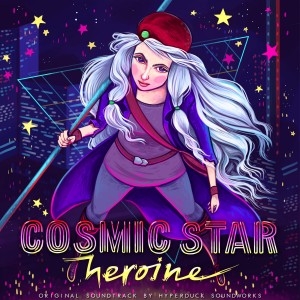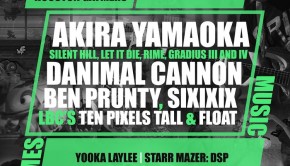Cosmic Star Heroine Original Soundtrack
 |
Album Title: Cosmic Star Heroine Original Soundtrack |
| Record Label: Hyperduck Soundworks |
|
| Catalog No. N/A |
|
| Release Date: April 11, 2017 |
|
| Purchase: Purchase on Bandcamp |
Overview
Few studios can modernize the ‘retro’ style quite like Zeboyd Games does. With releases like Cthulu Saves the World, Breath of Death VIII, and the last (and best) two entries in Penny Arcade’s On the Rain-Slick Precipice of Darkness, Zeboyd has shown that not only do they understand what should be in a retro-styled game, they also understand what should be modernized and streamlined for modern sensibilities. Their games have always had a sense of humor to them; homage and respect to what came before are delivered with tongue firmly placed in cheek. Their latest game, Kickstarter success story Cosmic Star Heroine, represents their first foray into ‘serious’ storytelling, and also their longest and most meticulously-designed project to date.
For the game’s score, Zeboyd turned once again to the Ireland-based Hyperduck Soundworks, who had previously composed the score to On the Rain-Slick Precipice of Darkness 4. In addition, they also composed the absurdly good soundtrack for Dust: An Elysian Tale, as well as the soundtracks for Kingdom Rush: Frontiers, A.R.E.S.: Extinction Agenda, and others. They also have several remixes on their Bandcamp page from such games as Chrono Trigger, Zelda, and Duke Nukem 3D. It’s obvious that they are quite enthusiastic about the blending of old and new, making the choice to once again partner with them for the Cosmic Star Heroine soundtrack seem like an obvious one for Zeboyd to make.
Body
The soundtrack opens with “The Cosmic Star Heroine,” which is an opening theme. This might sound like an incredibly obvious statement, but when I say ‘opening theme’, I mean something that belongs right out of a 1980’s-era anime. This is the kind of theme that conveys energy, style, and, if done right, a sense of impending awesomeness. I’ve always said that an album lives or dies by its opening track, and I knew immediately that this album was definitely going to, at the very least, not disappoint. That sentiment was reinforced by “L’Salle,” which serves as a theme for the main character of the series. If the first track set the mood for the game as a whole, the second track is a proper introduction of what to expect from the heroine herself. Without even playing the game itself, I can tell just by this song that “L’Salle” is someone who is quick to action and who is someone with finesse, style and the kind of take-no-shit approach to problem-solving exhibited by the best of science fiction adventure heroes.
Battle of Conflicts is the obvious battle theme of the game and it’s the sort of song that exhibits the best of what Hyperduck Soundworks has to offer the retro RPG subgenre. This is a song that takes inspiration from a great many sources and wears those inspirations quite plainly on its sleeve, or, more accurately, in its bassline. This is a track that would feel right at home in Chrono Trigger, to the point that it’s very obvious that was what they were going for. It’s not a direct take on that game’s battle theme, though, as once the track really gets going its other influence start to shine through. At various points in the theme you can get shades of Street Fighter, Final Fantasy VIII, and even F-Zero. The fact that this song can sound almost like any of these while never sounding exactly like any one of them is a feat that is quite difficult to pull off. I would say that this song hits the very slim target of ‘perfect homage’ that exists directly between ‘cover’ and ‘imitation’, and it hits that target dead center.
There is quite a bit of what I would consider ‘audio worldbuilding’ that needs to be done in any good soundtrack. This one is no exception, and this is accomplished with such songs as “Welcome to Nuluup City”, “Walking the Beat”, “Patch it Up”, and “Wicked Metropolis”, among others. These songs set up the world as a kind of amalgamation of 1980’s science fiction, while also playing toward the function of whatever area they’re present in. Later songs, such as Dark Science, serve to further set up the expectations for the specific areas they are most likely played in. These tracks are what I would consider the ‘functional’ tracks of the album, but not in the sense that they lack aesthetic. Rather, the songs exist for a purpose: to convey information just as critically as the level design and dialogue does. “A Conspiracy,” for example, is exactly the kind of track one would expect to play when sneaking into an area to investigate, well, a conspiracy. That these songs do it well enough that I can envision the style and substance of an area without ever having played the game at all is a testament to how well Hyperduck understands atmospheric storytelling.
Throughout the soundtrack, there are overtones of jazz and funk interwoven through the atmosphere. In that sense the soundtrack does its best to evoke an image of ‘cool’ that belongs in a very specific period of time. If there is any cyberpunk in this game’s DNA (and there is, at least a little), then it’s more reminiscent of Gibson’s Bridge trilogy than it is his Sprawl, and definitely more Blade Runner than it is Matrix. This is the 1980’s as seen looking backward through the lens of the 1990’s, idealized and transformed and simply cool in the way that a robot playing a saxophone in a jazzpunk band could be. The tracks “Gunmancer” and “The Hustler” evoke images of the kinds of characters at home in bars, pool halls, and futuristic speakeasies, and “Spy-Fi” gives the definite impression of exactly what the title of the track implies: a futuristic James Bond figure that can infiltrate effortlessly using guns, gadgets, and suave personality. “A Firebrand, An Agitator” on the other hand, is so reminiscent of Uptown Funk (hot damn!) that I keep trying to mentally fit the lyrics into the melody and am actually successful more than half the time.
There is no lack of tension-builders either. Songs like “Finality” or “Abyss of Space” set the tone for tense situations, and “Honeytrap” has all the feel of an impending military operation. The opposite end of the emotional spectrum is covered as well with tracks such as “Forlorn,” which is a low-key track that gives a definite sense of sadness and longing. Anyone who knows me knows that I do love songs that have a music box motif to them, and so obviously the refrain of “Forlorn” captured my heart immediately and didn’t let go.
Whether it’s intentional or not, there are some definite shades of Shoji Meguro in this soundtrack. Maybe it’s because I’ve played a lot of Persona lately (or, really, Shin Megami Tensei in general), but it’s really great to be able to pick out his brand of atmospheric electric guitar in tracks like “Echoes”, “Phantasms”, and “Araenu”. That’s even without mentioning “Dark Forces”, the obvious final encounter theme, which would be at home on any Shin Megami Tensei soundtrack or, for that matter, one of Uematsu’s Black Mages albums. My only complaint about hearing so much of Meguro in a few of these tracks is that I keep expecting to hear a signature Meguro guitar solo that never materializes. That’s not a knock against Hyperduck, though, as I’m not sure if the tracks would be too busy with the addition of anything else going on. What I can say is that Hyperduck often does the same thing with drums that Meguro tends to with guitar. There is an art to drum solos that slip into the heart of a song and manage to feel right at home, and the percussion on the more rock-inspired songs on this soundtrack are, I am happy to say, extremely on-point. The other moment of joy hit me in the final track, “The Resolution”, which is evocative of the songs that Canadian electronic rock band Faunts did for the Mass Effect soundtracks. It is quite fitting that the soundtrack ends with a song that is very reminiscent of something while still being its own distinctive original thing.
Summary
Cosmic Star Heroine Original Soundtrack is an album that knows its roots and embraces its influences. The album has both heart and soul, and on top of that, a dedication to the same kind of 1980’s-era cool that is reminiscent of Danger Zone. My only true worry about the Cosmic Star Heroine on my first listen was that there was not enough variation in the style of the tracks to distinguish them from each other. However, the more each track impressed me on its own, the more I realized that the similarities in the tracks are indicative of a unity of style. All in all, I would much rather have that than a soundtrack that is disjoint, incoherent, or disconnected.
Additionally, I found myself imagining what it would sound like to hear some of this music performed by a live band, and what kind of creations could be achieved by a dedicated remixer. Cosmic Star Heroine is delightfully retro in just the right way, making it a quality base for the covers and remixes that I hope we experience in the future. It is a soundtrack ripe with style, substance, and potential that shows a mastery the ability to pay homage to a great many influences without directly copying any of them.
Do you agree with the review and score? Let us know in the comments below!
5
Posted on April 24, 2017 by Greg Fisher. Last modified on April 24, 2017.














